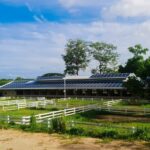South Africa’s agricultural sector plays a crucial role in the economy, providing food, employment, and livelihoods for millions of people. As the world faces increasing environmental challenges, integrating renewable energy sources into agricultural practices is essential for sustainability, resilience, and reducing greenhouse gas emissions. Here are ten ways to harness renewable energy in South African agriculture:
1. Solar-Powered Irrigation Systems
Significance:
Solar-powered irrigation systems use photovoltaic panels to generate electricity for pumping water from boreholes, rivers, or reservoirs, reducing reliance on fossil fuels and grid electricity.
Benefits:
- Cost Savings: Lower operating costs due to free solar energy, reducing fuel and electricity expenses.
- Off-Grid Capability: Provides access to water in remote areas without access to grid electricity.
- Environmental Impact: Reduces carbon emissions and environmental footprint compared to diesel-powered pumps.
2. Wind Turbines for On-Farm Energy Generation
Significance:
Wind turbines harness wind energy to generate electricity for on-farm operations, such as powering equipment, lighting, and facilities.
Benefits:
- Renewable Power Source: Utilizes abundant wind resources for clean, sustainable energy production.
- Grid Independence: Farms can operate independently from the grid or sell surplus electricity back to the grid.
- Long-Term Investment: Offers long-term energy cost stability and potential revenue through feed-in tariffs or renewable energy certificates.
3. Biogas Digesters for Waste Management and Energy Production
Significance:
Biogas digesters convert organic waste, such as animal manure and crop residues, into biogas through anaerobic digestion, providing renewable energy for heating, cooking, and electricity generation.
Benefits:
- Waste Management: Reduces methane emissions from organic waste decomposition and minimizes odor and pollution.
- Energy Generation: Produces biogas for on-farm energy needs, displacing fossil fuels and reducing greenhouse gas emissions.
- Nutrient Recycling: Produces nutrient-rich digestate as a byproduct for use as organic fertilizer.
4. Solar-Powered Cold Storage Facilities
Significance:
Solar-powered cold storage facilities utilize solar panels to power refrigeration units for storing perishable produce, such as fruits, vegetables, and dairy products.
Benefits:
- Extended Shelf Life: Maintains product quality and extends shelf life by providing consistent cooling temperatures.
- Reduced Spoilage: Minimizes post-harvest losses and food waste due to temperature fluctuations or power outages.
- Rural Access: Provides access to cold storage in remote areas without reliable grid electricity.
5. Biomass Heating Systems for Greenhouses
Significance:
Biomass heating systems use renewable biomass fuels, such as wood chips, crop residues, or biogas, to provide heat for greenhouse operations, including heating propagation beds, growing spaces, and water systems.
Benefits:
- Energy Efficiency: Provides efficient heating for greenhouses while reducing reliance on fossil fuels and grid electricity.
- Carbon Neutral: Utilizes renewable biomass fuels, which can be sourced locally, reducing carbon emissions and environmental impact.
- Economic Viability: Offers cost savings and potential revenue through biomass fuel production or utilization of waste materials.
6. Hydropower for Micro-Hydro Systems
Significance:
Micro-hydro systems harness the energy of flowing water, such as streams or small rivers, to generate electricity for on-farm use, including powering equipment, lighting, and small-scale processing facilities.
Benefits:
- Renewable Energy Source: Utilizes natural water resources for clean, sustainable energy production.
- Reliable Power Supply: Provides consistent electricity generation, especially in areas with reliable water flow.
- Environmental Impact: Minimizes environmental disruption compared to large-scale hydroelectric projects, preserving aquatic ecosystems.
7. Solar-Powered Livestock Watering Systems
Significance:
Solar-powered livestock watering systems use solar panels to power pumps for delivering water to watering troughs or tanks in grazing areas, ensuring reliable water supply for livestock.
Benefits:
- Remote Accessibility: Provides water access in remote or off-grid areas without access to electricity or water infrastructure.
- Cost-Effective: Reduces operating costs and maintenance compared to diesel-powered or grid-connected pumping systems.
- Environmental Sustainability: Minimizes environmental impact by utilizing clean, renewable solar energy for water pumping.
8. Solar-Powered Poultry Egg Incubators
Significance:
Solar-powered poultry egg incubators use solar energy to maintain optimal temperature and humidity levels for hatching eggs, supporting poultry production in off-grid or rural areas.
Benefits:
- Off-Grid Operation: Enables egg incubation in areas without access to grid electricity, improving hatch rates and productivity.
- Energy Efficiency: Provides consistent temperature control and reduces energy costs compared to traditional heating methods.
- Scalability: Suitable for small-scale and backyard poultry farmers, promoting local food production and livelihoods.
9. Geothermal Heating and Cooling Systems for Facilities
Significance:
Geothermal heating and cooling systems utilize the stable temperature of the earth’s subsurface to provide heating in winter and cooling in summer for agricultural facilities, such as offices, barns, and storage buildings.
Benefits:
- Energy Efficiency: Offers highly efficient heating and cooling with lower operating costs compared to conventional HVAC systems.
- Environmental Sustainability: Utilizes renewable geothermal energy, reducing greenhouse gas emissions and reliance on fossil fuels.
- Long-Term Investment: Provides long-term energy cost savings and potential return on investment through reduced energy expenses.
10. Solar-Powered Farm Security Systems
Significance:
Solar-powered farm security systems use solar panels to power surveillance cameras, motion sensors, and lighting for monitoring and protecting agricultural assets, such as crops, equipment, and livestock.
Benefits:
- Off-Grid Security: Provides security monitoring and deterrence in remote or off-grid areas without access to electricity or internet connectivity.
- Cost-Effective: Reduces installation and operating costs by utilizing solar energy for power supply, eliminating the need for grid connection or battery replacement.
- Scalability: Suitable for farms of all sizes, from smallholdings to large commercial operations, enhancing safety and asset protection.
Integrating renewable energy sources into South African agriculture offers numerous benefits, including cost savings, environmental sustainability, and energy independence. By leveraging solar, wind, biomass, hydro, and geothermal energy technologies, farmers can optimize productivity, reduce environmental impact, and build resilience to climate change. Embracing renewable energy solutions not only enhances the sustainability of agricultural operations but also contributes to South Africa’s transition to a low-carbon economy and a greener future for generations to come.
Join 'Farmers Mag' WhatsApp Channel
Get the latest Farming news and tips delivered straight to your WhatsApp
CLICK HERE TO JOIN






